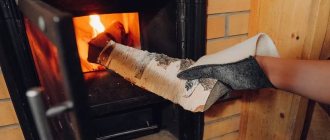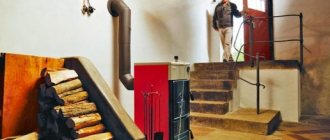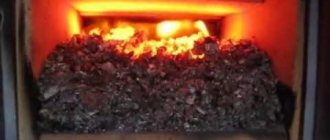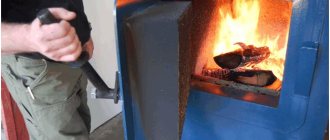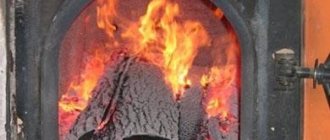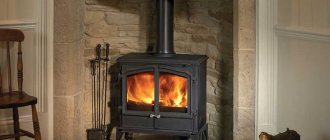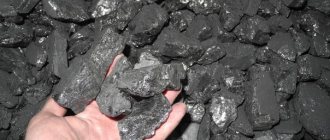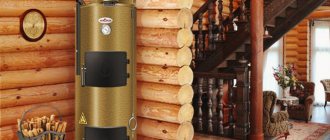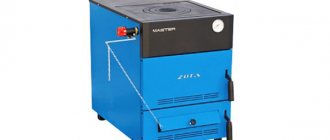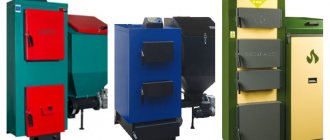What you need to know to calculate
Before calculating fuel for the entire season, you need to clarify a number of points, since firewood consumption depends on several factors. Here is a list of questions that require answers:
- How much heat is needed to heat a country house in your area of residence?
- What type of wood is planned to be burned?
- What is the moisture content of this wood? Is it freshly cut, semi-dry, or has it been around for a year or two?
- What is the efficiency (COP) of your heating unit? Indicated in the passport for a solid fuel boiler or stove.
You might say that rather than collecting all this data, it’s easier to use an online fuel consumption calculator. But not everything is so simple; the calculators presented on various sites are programs written by people. The calculation results must be checked to ensure their correctness. The best way is to calculate the amount of firewood and the cost of heating yourself, and then, to be sure, you can run the numbers on any online calculator.
Thermal energy consumption for heating a private home is determined by calculations performed by specialists or by an aggregated calculation method. For most homeowners, the second option is more acceptable, since you have to pay for the first. Its essence is this: on the coldest days, 10 kW/h of heat is allocated to heat 100 m² of building area located in a temperate climate zone. Taking into account the temperature change during the heating period, the average consumption during the season will be 5 kW/h.
Different types of wood release different amounts of thermal energy when burned, which is why it is important to know this in advance. The table below shows the calorific value of firewood of different types, referred to a measure of volume - 1 m³:
As can be seen from the table, the moisture content of wood fuel also affects the calorific value. The drier the wood, the more energy can be obtained per unit volume. This is understandable: when raw wood burns, part of the heat is spent on evaporating moisture and is not used to heat the house.
The efficiency indicator (EI) makes it clear what part of the thermal energy from burning fuel the boiler is able to direct into the heating system, throwing the rest into the chimney. This value is specified in the technical data sheet of each heat generator. For those who have not yet purchased a wood-burning heat source, here are the efficiency indicators for various heaters:
- when burning in a classic solid fuel boiler, 70 to 75% of the heat is used;
- the same, in a pyrolysis boiler - 80%;
- Russian brick or bell-type oven – 65%;
- steel or cast iron stove – no more than 55%.
Note. The efficiency value indicated for a pyrolysis heat generator corresponds to reality when working on dry wood (humidity 20%). If you “feed” this boiler with raw firewood, then its efficiency will not exceed 60...70%.
Which firewood is better
The wood that serves as raw material for firewood is far from identical in its properties.
Hard wood species such as birch, oak, hornbeam, beech, and yew burn hotter, have a high fibrous density, and burn more slowly.
Soft varieties have their advantages, for example: aspen produces 25% less heat than birch, but it perfectly maintains heat in a heated stove. Alder still shares a delightful aroma, as do coniferous varieties. Alder and aspen, added to the stove at the end of heating, remove soot and soot deposits in the chimney. But the formation of plaque, which can lead to clogging of the chimney, occurs during the combustion of essential oils and resins of pine, fir, and spruce. Conifers are also inferior in calorific value to birch and oak, but they dry out faster and are more suitable for kindling. Only fir sparks strongly, and larch emits a lot of carbon monoxide at the end of combustion and you need to be more careful with the damper.
Some types of fruit trees are classified as medium-hard wood and their calorific value is average. They burn, emitting an aroma, and are easy to prepare, since the wood can be split without much effort.
Based on the above, it is difficult to recommend any one type of wood for stove or fireplace firewood. As fuel, hard deciduous tree varieties are the most efficient. Even flame, high heat output, less soot and ash. But the aroma of coniferous trees has a therapeutic effect, and is well suited for lighting. By combining several varieties, it is possible to maintain both the working condition of the chimney, stove, and a comfortable microclimate throughout the cold period, subject to the initial investment in a good one. Otherwise, any heat, along with your funds, will fly into the pipe and evaporate through the cracks.
How is fuel calculated for the season?
There is a method according to which the amount of firewood to produce 1 kW of heat is calculated, after which the total fuel consumption is calculated. But this is a difficult path; to determine the wood consumption of a solid fuel boiler or stove, we suggest using a simpler formula:
In this formula:
- V – the required consumption of firewood in cubes for 1 month;
- Q – the amount of heat required to heat the house, kW/h;
- q – calorific value of 1 cubic meter of a particular type of wood depending on humidity, kW/m³;
- Efficiency is the efficiency of a wood-burning heat generator, indicated as a percentage.
The result of the calculation will be the volume of pure wood, but not chopped firewood or cylindrical logs. It is clear that the density of a storage cubic meter (storage meter) differs from the pure density of the substance, so the resulting volume should be divided by the conversion factor. This is the so-called full wood coefficient, whose values for different types of chopped firewood are presented in the table:
Knowing the consumption of firewood for 1 month, it is easy to calculate its consumption and financial costs for heating for the entire season, multiplying the result by the number of months in the heating period.
Wood briquettes
This type of briquettes is made from sawdust and other materials - waste from the wood processing industry. The raw materials are first heated and then pressed. To do this, use high pressure on the chips. Under pressure from the load, the wood releases lignin. It acts as glue. After it hardens, the mass does not lose its shape and is quite durable to the touch. Lignin is a natural material and does not cause any harm to the human body. Wood briquettes have some important characteristics. Fuel moisture content is 10%. As you can see, the moisture content of the finished material is several times lower than wood. At the moment of combustion, sawdust releases 4400 kcal/kg. If we compare this indicator and heating with sawdust with burning coal, we note that the indicator is 3910 kcal/kg.
Wood briquettes
If you compare it with coal, when burned, wood produces several times less carbon monoxide than other materials. The form in which wood blocks are produced is convenient in practice. This allows you to not take up a lot of space for fuel storage. Euro firewood is suitable as fuel not only for solid fuel boilers. They can be used to start a fire outdoors and to light a fireplace. Also, firewood in the form of wood blocks is easy to control consumption.
Calculation example for a house of 100 m²
To clarify the procedure for calculations, it is worth considering them using the example of a country house with an area of 100 m² and a heat consumption for heating of 5 kW/h on average per season. Let us assume that in a traditional boiler with an efficiency of 75%, split birch firewood 60 cm long with a humidity of 50% (freshly cut) is burned. Taking from the table above the calorific value for raw birch 2371 kW/m³, we substitute the data into the formula:
V = 720 x 5 / (2371 x 0.01 x 75) = 2.02 m³
Next, you need to find out the real monthly volume of birch logs, expressed in storage meters. We find the conversion factor in the second table; for chopped hardwood firewood 0.6 m long it is 0.71. Determine the actual volume of fuel:
2.02 / 0.71 = 2.85 m³
If the heating season lasts 6 months, you will have to burn 2.85 x 6 = 17.1 m³ of raw birch. Now you can check it with an online calculator on this Internet resource. The calculator readings differ from the calculated ones to a lesser extent - 2.8 m³ of birch logs is needed for 1 month, for the winter - 2.8 x 6 = 16.8 m³.
If you fold logs brought in bulk in the back of a dump truck normally, they will take up a little less space
The nuances of buying coal
The retail trade offers many types of barbecue coals directly from the manufacturer: birch, coconut, oak, aspen or special briquettes.
Each type of coal has its own specific application and has distinct characteristics.
Birch trees are the cheapest and safest option. High-quality coals from this wood provide uniform heat, do not emit unpleasant odors when smoldering, burn for a long time and are excellent for any culinary devices: barbecues, barbecues, grill ovens, and so on. They do not contain phosphorus, sulfur and other harmful substances. Experts advise using birch charcoal.
Coconut charcoal is a good imported product, but quite expensive compared to its birch counterpart. It is made from coconut shells and has several advantages:
- Increased heat transfer.
- No harmful chemicals.
- Burns without smoking and has no odors.
- Quite a long combustion time.
- Its consumption is five times less than when using any other varieties.
Briquettes are a good option for barbecues, however, they are also more expensive than the usual birch coals. It is produced by briquetting small pieces of wood.
Main advantages:
- High heat transfer and calorie content.
- Impressive burning time.
- Minimum amount of residual ash.
- Economical consumption of briquettes, which exceeds the consumption of wood (for similar purposes) several times.
The only disappointing drawback is that when making pressed briquettes,
Oak adhesive components are used - although a worthy combustion product for cooking, it is not entirely suitable for home kebabs. It is difficult to light and will require some skill to achieve its maximum effectiveness. The main purpose of this representative of the coal family is to use it in professional kebab shops, bars and restaurants.
Charcoal - this name on the packaging clearly indicates that there are softwood coals inside, which are absolutely not acceptable for barbecue. They always contain resins, which, when burned, will certainly spoil the taste of kebabs.
Stone - absolutely cannot be used in barbecues, even if the packaging says that it has undergone special treatment. When it burns, a whole bunch of harmful substances and specific odors are released, which will certainly transfer into the cooking kebab.
Sometimes aspen or pine trees are passed off as birch trees. It is quite easy to expose the deception - only birch ones have a brilliant anthracite color. Aspen and pine have no shine. They're just black.
When purchasing coal, first of all, you need to be concerned with the question: “How much does the product offered cost?” It should be remembered that even the cheapest birch charcoal cannot cost less than 100 rubles per 3 kg package. Lower prices are simply not possible.
The product packaging itself will help you choose the best option. It must contain min = 8 positions required by law: reliable name of the product, contact information of the manufacturer, information about certification, purpose of the product, and so on.
Which coal is better is decided purely individually, since each type of this product has its own specific specifics
Unfortunately, buying excellent charcoal for the barbecue is quite problematic. There are a lot of fakes in this segment of production and trade. And even Moscow cannot guarantee that the coal purchased at its retail outlets will be a quality product.
Therefore, it is much more practical and profitable for the average person to prepare good charcoal with his own hands.
